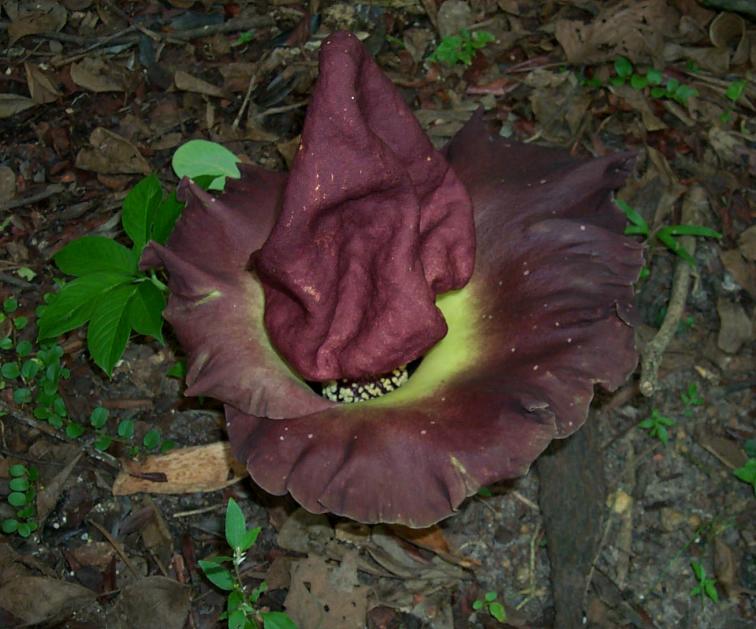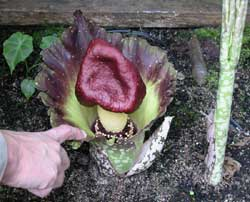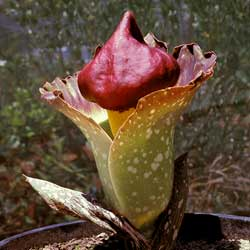Checklist of NT Vascular Plants
Plant
photos
a change of format
Amorphophallus paeoniifolius (Dennst.) Nicolson Elephant YamFam: ARACEAE Last updated 23 April 2006 |
|
| Habit Herb, 1 to 1.5 m high, arising from a large perennial underground tuber, flowers precede leaves. Bark Leaves Flowers Fruit Flowering Fruiting Features Habitat Cultivation Aboriginal uses Distribution Notes |

Photo: David Little |
References
Brock J. Top End Native Plants 1988 John Brock. Darwin 89
Other Amorphophallus paeoniifolius information
from: http://www.anbg.gov.au/gnp/interns-2002/amorphophallus-paeoniifolius.html
Amorphophallus paeoniifolius, the Elephant Yam, belongs to the Aroid family, Araceae. This family contains many plants recognised as having horticultural appeal such as the Arum Lilies, Monstera, Syngonium and Philodendron. The family is characterised by its inflorescence, consisting of a fleshy spike of small flowers (spadix) usually subtended by a large bract (spathe). Amorphophallus paeoniifolius occurs through the tropics, from India to New Guinea and to Australia where it is found in tropical Queensland and Northern Territory in seasonally dry areas. The species was previously called Amorphophallus campanulatus.
This plant produces a single inflorescence followed by a solitary leaf. The plant is deciduous, dying back to a large underground corm, weighing up to 8kg, after the growing season.
Some people regard the inflorescence as bizarre. It comprises a large spadix crowned with a bulbous purple knob, encircled by a fleshy purple and green-blotched spathe up to 50cm wide. On successful pollination of the female flowers the spadix can extend to 2m tall. The fresh inflorescence emits an odour reminiscent of rotting flesh to attract pollinating carrion flies and beetles.
The solitary leaf resembles a small tree. The leaf blade is much divided into hundreds of leaflets and can reach over 1m wide. This blade sits atop a thick fleshy stem up to 13cm diameter and 2m tall. The pustular surface of the stem is attractively blotched with paler shades of green.
Amorphophallus paeoniifolius is quite hardy in tropical areas when planted in rich, well-drained soil in a sheltered, humid position. In temperate areas the plant can be grown successfully as a container specimen. A pot twice the diameter of the corm should be selected and filled with rich, well-drained potting mix.
The corm needs to be planted well below the soil surface to give the plant stability. Ample water is required during the growing season but the amount can be reduced dramatically during dormancy. Corms of potted specimens can be removed from the pot and stored dry to prevent frost damage. The occasional application of a high phosphorus fertilizer (NPK 15,30,15) will ensure maximum growth and health of the plant.
The plant can be propagated from offsets of the corm or by fresh seed sown in a slightly acidic seed raising mix. As most of the starch stored in the corm is used to produce the leaf, transplanting should not be attempted until the leaf has wilted and the new corm developed.

 Photos by M. Fagg
Photos by M. Fagg
The corms of some varieties are edible and grown as food crops in several Asian countries, especially Indonesia.
The main horticultural pests affecting Amorphophallus paeoniifolius is nematodes.
Amorphophallus - Deformed or shapeless penis. paeoniifolius - Peony-like foliage.
Text by Tony Roberts (2002 Botanical Intern)
Amorphophallus paeoniifolius (Dennst.) Nicolson by Wilbert Hetterscheid
The information here in is adapted from W. Hetterscheid and S. Ittenbach, 1996, Everything You Always Wanted to Know About Amorphophallus, but Were Afraid to Stick Your Nose Into!!!!!, Aroideana 19: 7-131.
From http://www.aroid.org/genera/amorphophallus/paeoniifolius/paeon.html
Amorphophallus paeoniifolius (Dennst.) Nicolson [Synonyms: A. campanulatus Decne (non Roxb.), A. dubius Bl., A. sativus Bl., A. decurrens (Blanco) Kunth, A. chatty Andre, A. virosus N.E.Br., A. rex Prain, A. malaccensis Ridl., A. gigantiflorus Hayata, A. microappendiculatus Engl., A. bangkokensis Gagnep., A. dixenii Lars. & Lars.].
Description: Tuber depressed-globose, to about 30 cm in diameter, about 20 cm high, dark brown, root scars prominent, annulate, offsets produced every season, these thick rhizomatous, to about 10 cm long, about 4 cm in diameter. Leaf solitary or two; petiole to about 2 meters long and about 20 cm in diameter, background color pale to dark green or blackish green, usually with large and small pale blotches and numerous tiny dark dots, the large blotches often confluent, especially near the base, surface shallowly corrugate to strongly echinate-verrucate; lamina highly dissected, to about 3 meters in diameter; leaflets rounded, oval, ovate, obovate, elliptic, elliptic-oblong, elliptic-lanceolate or lanceolate, acuminate, 3 to 35 cm long, 2 to 12 cm in diameter, upper surface midgreen, lower surface mid-green or pale green. Inflorescence short-peduncled; peduncle 3 to 20 cm long, about 1 to 8 cm in diameter, usually paler and smoother than petiole; spathe campanulate, broader than long, 10 to about 40 cm long, 15 to about 60 cm in diameter, base and limb often separated by a shallow constriction, limb spreading, strongly undulate, base outside very variable, background color ranging from pale green to dark brown, usually with large and small, circular paler spots, base inside lower part deep maroon, upper zone dirty whitish or very pale pinkish, limb outside as base but with more prominent maroon flushes, especially near the margin, limb inside usually glossy dark maroon, base within densely verrucate, verrucae variable, mostly conical, fleshy. Spadix sessile, shorter or longer than spathe, 7 to about 70 cm long.
Distribution: Madagascar, eastwards via India to Malesia, southern China, Indochina, Polynesia, northern Australia (in almost all imaginable secondary conditions, either secondary forest or highly disturbed areas, in dappled shade or fully exposed areas, altitude 0 to 700 meters).
Notes: The large number of synonyms presented here originates from many an author's attempt to define a set of the variable characters of A. paeoniifolius as supporting the separation of new species from the main body of the species. The main body being specimens with large, pyramidal appendices, very long styles, bilobed stigmas and fairly rough petioles. Mostly the spadix is longer than the spathe but in inflorescences developing from small tubers this is reversed, and occasionally the appendix takes a more isodiametric shape, but this may also be found in large specimens. The relative length of the female zone compared to the male zone varies at random. The shape of the male zone depends strongly on the width of the appendix base. When the latter is large, the male zone is often roofed against the underside of the appendix resulting in a strong obconic shape. Alternatively, when the appendix base is narrow, the male zone is cylindric or only slightly obconic. The degree of roughness of the petiole may vary within one clone or specimen but is usually constant. In certain areas roughness is ubiquitous (e.g. in Papua New Guinea), but may vary from rough to near smooth (e.g. Java, India). So far no correlation between any of these characters has been found on a large scale. Amorphophallus paeoniifolius has a centuries old cultivation history in the Asian and Indopacific region and its natural distribution has been totally obscured because many specimens found in the wild are (probably) weedy escapees from cultivation. The closest relative of A. paeoniifolius is A. hirsutus.
Cultivation: Grow in any fertile soil. The tuber may be stored dry when dormant.
Return to Home page
